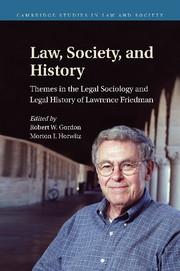Book contents
- Frontmatter
- Contents
- Contributors
- Introduction
- PART I OVERVIEWS AND ASSESSMENTS OF FRIEDMAN'S WORK
- PART II APPLICATIONS OF CONCEPTS, INSIGHTS, AND METHODS IN FRIEDMAN'S WORK
- Legal Culture
- Total Justice
- 7 The Travails of Total Justice
- 8 “Total Justice” and Political Conservatism
- 9 Failures of War Tribunals
- PART III THE LEGAL PROFESSION
- PART IV LAW AND LARGE AREAS OF SOCIAL LIFE
- PART V FACTS FROM THE UNDERGROUND: DIGGING LEGAL HISTORY OUT OF THE CELLAR
- PART VI PERSPECTIVES FROM OTHER CONCEPTUAL WORLDS
- Index
- Titles in the series
- References
8 - “Total Justice” and Political Conservatism
Published online by Cambridge University Press: 07 October 2011
- Frontmatter
- Contents
- Contributors
- Introduction
- PART I OVERVIEWS AND ASSESSMENTS OF FRIEDMAN'S WORK
- PART II APPLICATIONS OF CONCEPTS, INSIGHTS, AND METHODS IN FRIEDMAN'S WORK
- Legal Culture
- Total Justice
- 7 The Travails of Total Justice
- 8 “Total Justice” and Political Conservatism
- 9 Failures of War Tribunals
- PART III THE LEGAL PROFESSION
- PART IV LAW AND LARGE AREAS OF SOCIAL LIFE
- PART V FACTS FROM THE UNDERGROUND: DIGGING LEGAL HISTORY OUT OF THE CELLAR
- PART VI PERSPECTIVES FROM OTHER CONCEPTUAL WORLDS
- Index
- Titles in the series
- References
Summary
In Total Justice (1985), Lawrence M. Friedman describes a dramatic change in American legal culture. Friedman defines legal culture as ordinary people's views about what law is, should be, and should provide. Over the last century or so, he contends, American legal culture has come to include a widespread demand for “total justice.” In turn that demand has generated thoroughgoing change in the law and legal life of the country. One strand in the legal culture of total justice is “a general expectation of recompense” for arbitrarily inflicted devastating losses, particularly accidentally imposed personal injuries. A second strand is the “expectation of fair treatment.” Friedman argues that Americans increasingly expect nondiscriminatory treatment and some version of “due process of law” when institutions deny them some important benefit. They expect fair treatment not only in courts and government agencies but also “in all settings: in hospitals and prisons, in schools, on the job, in apartment buildings.”
In its focus on popular legal culture, Total Justice reiterates a theme that runs through the entire library of Friedman's books and articles: At least in the United States, developments in popular legal culture, much more than the theorizing of legal scholars and judges, are the primary drivers of legal change. In turn, the evolution of legal culture is driven primarily by social changes that affect the day-to-day texture of life. Thus the most powerful insights in the book concern the social changes that have engendered a popular legal culture attuned to total justice.
- Type
- Chapter
- Information
- Law, Society, and HistoryThemes in the Legal Sociology and Legal History of Lawrence M. Friedman, pp. 118 - 136Publisher: Cambridge University PressPrint publication year: 2011

